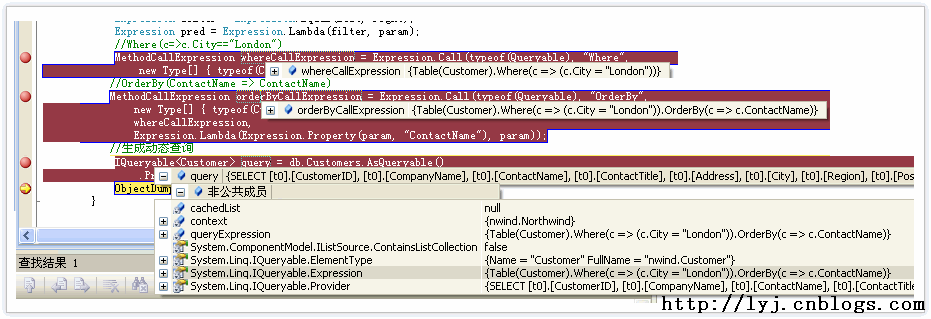動態查詢
有這樣一個場景:應用程序可能會提供一個用戶界面,用 戶可以使用該用戶界面指定一個或多個謂詞來篩選數據。這種情況在編譯時不知 道查詢的細節,動態查詢將十分有用。
在LINQ中,Lambda表達式是許多 標准查詢運算符的基礎,編譯器創建lambda表達式以捕獲基礎查詢方法(例如 Where、Select、Order By、Take While 以及其他方法)中定義的計算。表達式 目錄樹用於針對數據源的結構化查詢,這些數據源實現IQueryable<T>。 例如,LINQ to SQL 提供程序實現 IQueryable<T>接口,用於查詢關系數 據存儲。C#和Visual Basic編譯器會針對此類數據源的查詢編譯為代碼,該代碼 在運行時將生成一個表達式目錄樹。然後,查詢提供程序可以遍歷表達式目錄樹 數據結構,並將其轉換為適合於數據源的查詢語言。
表達式目錄樹在 LINQ中用於表示分配給類型為Expression<TDelegate>的變量的Lambda表 達式。還可用於創建動態LINQ查詢。
System.Linq.Expressions命名空間 提供用於手動生成表達式目錄樹的API。Expression類包含創建特定類型的表達 式目錄樹節點的靜態工廠方法,例如,ParameterExpression(表示一個已命名 的參數表達式)或 MethodCallExpression(表示一個方法調用)。編譯器生成 的表達式目錄樹的根始終在類型Expression<TDelegate>的節點中,其中 TDelegate是包含至多五個輸入參數的任何TDelegate委托;也就是說,其根節點 是表示一個lambda表達式。
下面幾個例子描述如何使用表達式目錄樹來 創建動態LINQ查詢。
1.Select
下面例子說明如何使用表達式樹 依據 IQueryable 數據源構造一個動態查詢,查詢出每個顧客的ContactName, 並用GetCommand方法獲取其生成SQL語句。
//依據IQueryable數據 源構造一個查詢
IQueryable<Customer> custs = db.Customers;
//組建一個表達式樹來創建一個參數
ParameterExpression param =
Expression.Parameter(typeof (Customer), "c");
//組建表達式樹:c.ContactName
Expression selector = Expression.Property(param,
typeof (Customer).GetProperty("ContactName"));
Expression pred = Expression.Lambda(selector, param);
//組建表達式樹:Select (c=>c.ContactName)
Expression expr = Expression.Call(typeof (Queryable), "Select",
new Type[] { typeof (Customer), typeof(string) },
Expression.Constant(custs), pred);
//使用表達式樹來生成動態查詢
IQueryable<string> query = db.Customers.AsQueryable()
.Provider.CreateQuery<string>(expr);
//使用GetCommand方法 獲取SQL語句
System.Data.Common.DbCommand cmd = db.GetCommand (query);
Console.WriteLine(cmd.CommandText);
生成的 SQL語句為:
SELECT [t0].[ContactName] FROM [dbo]. [Customers] AS [t0]2.Where
下面一個例子是“搭建 ”Where用法來動態查詢城市在倫敦的顧客。
IQueryable<Customer> custs = db.Customers;
// 創建一個參數c
ParameterExpression param =
Expression.Parameter(typeof(Customer), "c");
//c.City=="London"
Expression left = Expression.Property(param,
typeof(Customer).GetProperty ("City"));
Expression right = Expression.Constant ("London");
Expression filter = Expression.Equal(left, right);
Expression pred = Expression.Lambda(filter, param);
//Where(c=>c.City=="London")
Expression expr = Expression.Call(typeof(Queryable), "Where",
new Type[] { typeof(Customer) },
Expression.Constant(custs), pred);
//生成動態查詢
IQueryable<Customer> query = db.Customers.AsQueryable()
.Provider.CreateQuery<Customer>(expr);
生成的SQL 語句為:
SELECT [t0].[CustomerID], [t0].[CompanyName], [t0].[ContactName],
[t0].[ContactTitle], [t0].[Address], [t0]. [City], [t0].[Region],
[t0].[PostalCode], [t0].[Country], [t0]. [Phone], [t0].[Fax]
FROM [dbo].[Customers] AS [t0] WHERE [t0]. [City] = @p0
-- @p0: Input NVarChar (Size = 6; Prec = 0; Scale = 0) [London]
3.OrderBy本例既實現排序功能又實現了過濾功能。
IQueryable<Customer> custs = db.Customers;
//創建一個 參數c
ParameterExpression param =
Expression.Parameter (typeof(Customer), "c");
//c.City=="London"
Expression left = Expression.Property(param,
typeof(Customer).GetProperty ("City"));
Expression right = Expression.Constant ("London");
Expression filter = Expression.Equal(left, right);
Expression pred = Expression.Lambda(filter, param);
//Where(c=>c.City=="London")
MethodCallExpression whereCallExpression = Expression.Call(
typeof(Queryable), "Where",
new Type[] { typeof(Customer) },
Expression.Constant(custs), pred);
//OrderBy(ContactName => ContactName)
MethodCallExpression orderByCallExpression = Expression.Call(
typeof(Queryable), "OrderBy",
new Type[] { typeof(Customer), typeof(string) },
whereCallExpression,
Expression.Lambda(Expression.Property
(param, "ContactName"), param));
//生成動態查詢
IQueryable<Customer> query = db.Customers.AsQueryable()
.Provider.CreateQuery<Customer> (orderByCallExpression);
下面一張截圖顯示了怎麼動態生成動 態查詢的過程

生成的SQL語句為:
SELECT [t0].[CustomerID], [t0].[CompanyName], [t0].[ContactName],4.Union
[t0].[ContactTitle], [t0].[Address], [t0].[City], [t0].[Region],
[t0].[PostalCode], [t0].[Country], [t0].[Phone], [t0].[Fax]
FROM [dbo].[Customers] AS [t0] WHERE [t0].[City] = @p0
ORDER BY [t0].[ContactName]
-- @p0: Input NVarChar (Size = 6; Prec = 0; Scale = 0) [London]
下面的例子使用表達式樹動態查詢顧客和雇員同在的城 市。
//e.City
IQueryable<Customer> custs = db.Customers;
ParameterExpression param1 =
Expression.Parameter(typeof(Customer), "e");
Expression left1 = Expression.Property(param1,
typeof (Customer).GetProperty("City"));
Expression pred1 = Expression.Lambda(left1, param1);
//c.City
IQueryable<Employee> employees = db.Employees;
ParameterExpression param2 =
Expression.Parameter(typeof (Employee), "c");
Expression left2 = Expression.Property(param2,
typeof(Employee).GetProperty ("City"));
Expression pred2 = Expression.Lambda(left2, param2);
//Select(e=>e.City)
Expression expr1 = Expression.Call(typeof(Queryable), "Select",
new Type[] { typeof(Customer), typeof(string) },
Expression.Constant(custs), pred1);
//Select(c=>c.City)
Expression expr2 = Expression.Call(typeof(Queryable), "Select",
new Type[] { typeof(Employee), typeof (string) },
Expression.Constant(employees), pred2);
//生 成動態查詢
IQueryable<string> q1 = db.Customers.AsQueryable()
.Provider.CreateQuery<string>(expr1);
IQueryable<string> q2 = db.Employees.AsQueryable()
.Provider.CreateQuery<string>(expr2);
//並集
var q3 = q1.Union(q2);
生成的SQL語句為:
SELECT [t2].[City]
FROM (
SELECT [t0].[City] FROM [dbo]. [Customers] AS [t0]
UNION
SELECT [t1].[City] FROM [dbo].[Employees] AS [t1]
) AS [t2]